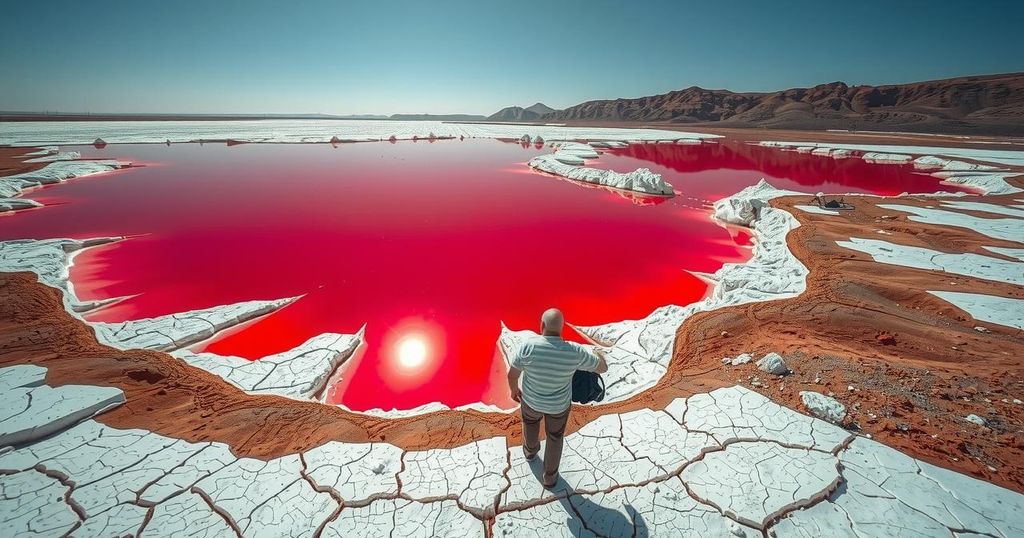Lake Natron: Tanzania’s Blood-Red Lake That Turns Animals to Stone
Lake Natron in Tanzania is a unique and dangerous natural site, known for its vivid red waters that can turn dead animals into calcified statues. The lake is home to thriving lesser flamingos that have adapted to its extreme conditions. Conservation efforts play a vital role in maintaining this intriguing yet lethal ecosystem.
Nestled in northern Tanzania, Lake Natron is a stunning yet deadly natural wonder. This crimson lake entices visitors with its bizarre beauty but has properties that can spell doom for animals. It is one of the most extraordinary natural phenomena in Africa, as its hostile environment can transform deceased creatures into eerie, calcified statues due to the lake’s extreme chemical makeup.
The vibrant, blood-red waters of Lake Natron shine like a gem under the African sun. The lake features a high concentration of specialized microorganisms that thrive in its alkaline waters, producing vivid red pigments. These microbes are incredibly adaptable, making it possible for them to survive in pH levels close to 10.5, nearly as caustic as household ammonia. The lake’s chemistry, shaped by volcanic activity in the East African Rift System, creates a cocktail of dangers for any animal nearby.
During drier periods, the lake’s size diminishes sharply, increasing its toxic mix. Water temperatures can reach a scorching 140°F (60°C), and, although it stretches up to 9 miles (15 kilometers), the lake is very shallow—averaging just 1.6 feet (0.5 meters) in depth—which results in rapid evaporation. This leads to dramatic seasonal shifts that add to its perilous environment.
One of the most striking aspects of Lake Natron is its bizarre ability to turn dead wildlife into calcified statues. Creatures that die near its shores undergo a natural preservation process, where sodium carbonate in the water replaces organic tissues with mineral deposits. The outcome leaves these unfortunate animals resembling stone sculptures, eerily preserved in time.
Famed photographer Nick Brandt highlighted this fascination in 2013 with his collection “Across the Ravaged Land.” His images captured the chilling beauty of calcified birds and bats, which appear as if they are merely paused in time. The petrification is a quick process; animals that die in close proximity quickly absorb the mineral-rich water, and evaporation causes mineralization throughout their bodies, mimicking ancient stone artwork.
Interestingly, the lake provides suitable conditions for various specialized life forms despite its dangers. Most notably, Lake Natron is crucial for lesser flamingos, which rely on the lake for breeding. These birds possess adaptations—such as tough, scaled legs—that help them thrive in the alkaline waters. Reports suggest that between 1.5 and 2.5 million lesser flamingos nest in Lake Natron, accounting for about 75% of their total population globally.
The same microorganisms responsible for the lake’s unique color provide sustenance for these flamingos, illustrating how life can adapt and flourish even in extreme locations. The flamingos develop their pink hue from the pigments in their diet of cyanobacteria, forming an intriguing food web in this harsh habitat.
Lake Natron also serves as a model for scientists studying extreme environments on Earth and their parallels on other planets, such as Mars. The adaptations found in this unusual ecosystem provide valuable insights into biological resilience, hinting at how life might take shape beyond our world.
For those adventurous souls looking to visit, Lake Natron beckons but comes with risks. Travelers must approach this wonder with caution, guided by locals who know the safest viewing spots near the lake’s flamingo colonies. The surrounding areas offer a stark contrast, with salt marshes and wetlands teeming with wildlife such as pelicans and even wildebeest, providing safe observation without exposure to the caustic waters.
Conservation efforts are underway to protect Lake Natron’s fragile ecosystem. The Tanzania Wildlife Management Authority has strict tourism protocols in effect to ensure that human activities do not interfere with flamingo breeding or the lake’s unique environment. Such measures are crucial for sustaining this remarkable natural phenomenon that embodies both death and life in a delicate balance.
Indeed, Lake Natron stands as a testament to the extremes of nature, showcasing that even the harshest environments can hold profound beauty and resilience.
In summary, Lake Natron in Tanzania is a remarkable yet treacherous ecosystem that shapes the lives of its inhabitants in unique ways. While its blood-red waters can petrify animals, it also serves as a breeding ground for lesser flamingos, illustrating the duality of life and death in nature. Conservation efforts are critical to preserving this extraordinary environment, ensuring it continues to fascinate future generations.
Original Source: thinkstewartville.com




Post Comment